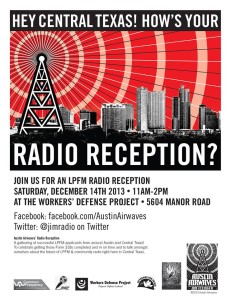 I was happy to see that our friend Jim Ellinger’s Low Power FM event last Saturday in Austin, Texas went well. “Half a dozen applicants, commissioners and academics, radio talent and sponsors showed up,” the Austin Airwaves Facebook page reports. “A phone in call from Ian Smith of the Prometheus Radio Project answered a lot of questions. Good meeting!”
I was happy to see that our friend Jim Ellinger’s Low Power FM event last Saturday in Austin, Texas went well. “Half a dozen applicants, commissioners and academics, radio talent and sponsors showed up,” the Austin Airwaves Facebook page reports. “A phone in call from Ian Smith of the Prometheus Radio Project answered a lot of questions. Good meeting!”
Reading this, I went back to the Federal Communications Commission’s recent posting of LPFM mutually exclusive [MX] application clusters and noticed something: there are a lot of Low Power FM applications in the Lone Star State.
Austin, for example, has a cluster of six, which includes the Workers Defense Project, at whose headquarters the LPFM meeting took place. Dallas/Fort Worth has an MX cluster of thirteen around two LPFM channels. Applicants include the University of Texas Amateur Radio Club and the Champions of Life Christian Church. The San Antonio area has one cluster of six and another of three. Hopefuls for the six group include South San Antonio Community Radio, “Empowering Kids,” and “Alamo Methodist” (Church, I presume).
Houston has one cluster of nine, another (Houston/Pasadena) of five, yet another of five, and a smaller cluster of two. Lots of churches in that nine group; the Houston Institute For Culture and William Marsh Rice University (aka Rice University) in the second; five mostly Latino churches in the third.
Then there are clusters of two, three, and four applicants in Tyler, Terrell, Killeen, Brownsville, Corpus Christi, Denton, Wichita Falls, Odessa, Midland, Lubbock, El Paso, and Laredo. Add to that little multi-city clusters in Conroe/Montgomery, Harlingen/Rancho Viejo, Galveston/Lamarque, McAllen/Mission, and Edinburg/Mccallen—mostly two applications in these regions.
Wow . . . however this plays itself out, it looks like Texas will have a lot more Low Power FM stations over the next year or so. Congratulations to all these applicants for the hard work they put into filing with the FCC.
By the way, for my last Low Power FM story on MX clusters, I asked Sanjay Jolly, Policy Director for the Prometheus Project on what applicants can do if they find themselves in one of these groups.
“My general advice to LPFM applicants is to learn and understand exactly what your options are,” Jolly replied:
“The whole process, even with the help of the [FCC] Media Bureau’s recent public notices, can be opaque and convoluted if you are not already familiar with FCC bureaucracy. There a number of factors – applicant points, minor/major amendments, opportunities for timeshares, etc. – that create opportunities and barriers that are unique to every applicant.
With regard to technical issues, the FCC has significant flexibility to resolve technical settlements. Already groups can file minor amendments and timeshare agreements that could include technical amendments. Once the Media Bureau releases public notices for the tentative MX group selectees, applicants will be able to file major amendments, which include channel changes. In certain cases, coordination with other LPFM applicant groups could be very beneficial. In fact, for some it is the only way they will get on the air.
So again, my advice is to figure out what lies between you and an LPFM station, identify all the options available to you (timeshares, amendments, etc.), and determine a strategic way forward.”
LPFM Watch is a weekly feature on Radio Survivor every Thursday.



